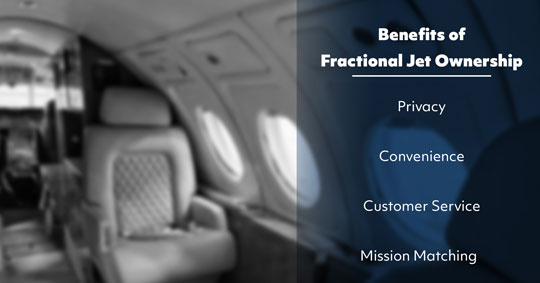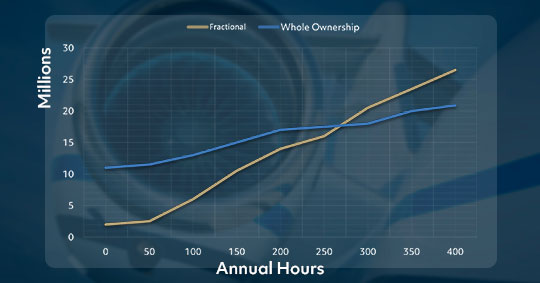December 3, 2025
On Pointe Podcast: Helping Family Offices Make Smart Aviation Decisions
Read More
Fractional jet ownership is a great option for flyers who want to experience private aviation, but do not fly enough to validate whole ownership. Just like whole ownership and charter, fractional has its own distinct advantages.
If you desire the convenience that comes along with private aviation, but do not want to pay the cost for a wholly owned aircraft, fractional jet ownership may be the perfect alternative for you. Fractional ownership allows you to purchase a share of an aircraft, making you a partial owner. Co-owners of the aircraft pay for a predetermined number of hours that they can fly on the jet.
If you think fractional jet ownership is a viable answer to your travel mission, learn more about the benefits and costs compared to both whole ownership and charter.
The fixed costs and variable costs associated with fractional jet ownership are fairly high, because you are only paying for those hours when you occupy a seat on a flight. In a life cycle cost evaluation, there is low residual and terminal value, but this is all to be expected because of an exceptionally low capital requirement at the front of fractional ownership.
When used at the appropriate time, fractional jet ownership can be a valuable option to complete your aviation missions. There are a number of circumstances where fractional ownership makes sense:
Low Utilization – If you aren’t flying enough hours to justify whole ownership, fractional lift might be your best option. The lower capital of fractional ownership makes it optimal when you are flying about two hundred hours in a year. There is a point in time when whole ownership becomes less expensive than fractional. At two hundred fifty to three hundred hours flown in a year, whole ownership can be more cost effective.
Eliminating Deadhead – Fractional jet ownership only requires you to pay for the hours that you are physically on the airplane. With a wholly owned aircraft, depending on your mission, you could be paying for the deadhead hours, when nobody is on the aircraft.
Simultaneous Departures – There are a number of scenarios when multiple aircraft are required, fractional jet ownership can simplify these missions tremendously. Fractional ownership grants you access to multiple aircraft simultaneously.
Upgrade/Downgrade – Fractional jet ownership gives you the flexibility to upgrade or downgrade your aircraft which is not an option with a wholly owned aircraft. Your fractionally owned midsize aircraft can be upgraded or downgraded depending on your mission.
Supplemental Lift – Fractional jet ownership is not mutually exclusive to whole ownership. Fractional ownership becomes a great option to utilize in addition to your wholly owned aircraft. Just like upgrading and downgrading, you can implement fractional ownership to use an aircraft that fits your current mission. If you have trips taking place far from the home base of your wholly owned aircraft, utilize fractional jet ownership to save money.

There are several benefits that fractional jet ownership has to offer, some of those include:
Privacy - Fractional ownership provides you with the complete private aviation experience. The aircraft you utilize will be listed under the provider's name, meaning your name is kept out of flight tracking databases.
Convenience - There is fantastic accessibility. One of the biggest perks of fractional ownership is that there is a singular point of contact. You can make one phone call to schedule your entire trip quickly. Your flight can be prepared for you in hours.
Customer Service - Along with convenience, there is a remarkably high quality of service. Customer experience is generally excellent.
Mission Matching - Fitting the aircraft to your mission is a crucial element to fractional ownership that you should keep in mind when weighing the positives and negatives. This becomes extremely useful in those cases where you have multiple bases of operation in separate locations.
The issue with fractional ownership arises with high utilization. The cost of fractional jet ownership can become quite expensive the more hours you are flying.

If you are trying to decide whether fractional jet ownership is right for you, compare it to the other private aviation options, whole aircraft ownership and charter.
Whole Ownership - Whole ownership has high capital costs, relative to fractional ownership when you are flying between one hundred to three hundred hours yearly. The fixed costs of a whole ownership are also high, but the variable costs are quite low over the ownership lifecycle. There is an also high residual value that comes along with aircraft ownership.
The glaring benefit to whole ownership is that you have complete control over all aspects of the aircraft. You can select everything within your flight operation, from your crew to your maintenance team. If you are looking for these levels of customization, then whole ownership is for you.
Along with whole ownership comes the highest form of personal customer service. If you have fully customized your airplane to the exact way you like it, and your crew becomes familiar with you, the experience is unmatched.
With high levels of utilization comes low life cycle costs. You will have the high capital and fixed costs, but at those low variable costs, you are going to start to the ground when you are flying at higher levels of utilization.
The disadvantage of whole ownership compared to fractional jet ownership are that you are using one aircraft to fit all missions. Simultaneous departures are not an option, similarly with multiple origins for departure. There are positioning fees depending on the way you travel and your travel patterns. All travel must be scheduled around maintenance, limiting your hours in the air when your aircraft is being worked on. If you have low levels of utilization, there will be very high life cycle costs. Finally, you will have to determine how long you should own your aircraft.
Many aspects of these two options will be influenced by factors such as:
With all of that being said, everyone’s mission is different. While whole ownership may be perfect for one company’s mission, fractional may best suit you.
Guardian Jet welcomes the opportunity to discuss your individual situation in great detail, so we can help you build a model that is custom tailored specifically for you. We want to help you make the right selection for your mission. This means considering all three options, fractional jet ownership, whole ownership, and charter. We’re more than happy to discuss your particular needs. To learn more, give us a call at 1-203-453-0800.
Contact Guardian JetLearn the latest about aircraft sales, brokerage trends and more.
By submitting your information, you acknowledge that you may be sent marketing material and newsletters.
Your information is secure and will never be shared with any third party. View our Privacy Policy